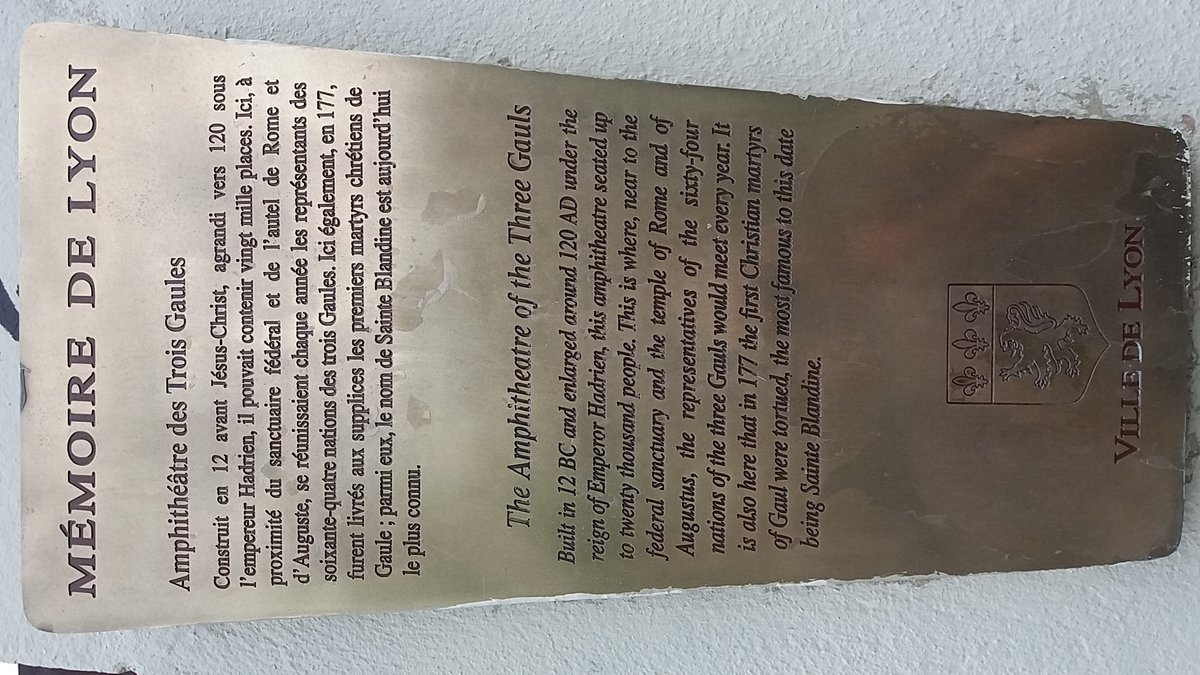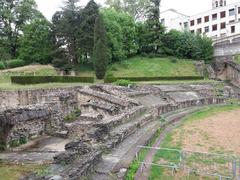
Amphitheater of Lyon Visiting Hours, Tickets, and Historical Sites Guide
Date: 14/06/2025
Introduction
The Amphitheater of the Three Gauls (Amphithéâtre des Trois Gaules) is a remarkable Roman monument in Lyon’s historic Croix-Rousse district. Built in 19 AD, it stands as a testament to Lyon’s legacy as Lugdunum—the capital of Roman Gaul. Originally seating about 1,800 spectators and later expanded to 20,000, the amphitheater became a political, religious, and cultural center. Today, its ruins within the Jardin des Plantes invite visitors to discover the city’s ancient roots, offering free entry year-round and easy access to other key Roman sites in Lyon (History Hit; Visit On Slyon; evendo.com).
Table of Contents
Historical Overview
Origins and Construction
The amphitheater was erected around 19 AD under Emperor Tiberius. Strategically positioned at the foot of Croix-Rousse hill near the Rhône and Saône rivers, it symbolized Roman authority and local integration with an initial capacity for 1,800 spectators. Its elliptical arena—measuring about 67.6 by 42 meters—was surrounded by basement walls and a channel, and funded by a local Gallic family newly granted Roman citizenship (Spotting History; History Tools).
Sanctuary and Imperial Cult
The amphitheater was not just for entertainment. It formed part of the Sanctuary of the Three Gauls, the federal religious and political center for 60 Gallic tribes. Each year, the Concilium Galliarum convened here to honor the emperor with ceremonies and games, reinforcing unity and Roman imperial power (Visit On Slyon; History Tools).
Expansion and Architecture
In the early 2nd century, the amphitheater was expanded under procurator C. Julius Celsus (130–136 AD), increasing its capacity to about 20,000 by adding two galleries and extending its width to 105 meters. Roman and local construction techniques created a sophisticated structure, rivaling other great Roman arenas (Wikipedia; Spotting History).
Historical Significance
The site is renowned for the martyrdom of Saints Blandina and Pothinus during the Christian persecutions of 177 AD. A commemorative pillar and a memorial post mark these events, and Pope John Paul II honored the site with a visit in 1986. Beyond its spiritual importance, the amphitheater hosted gladiatorial contests and public spectacles central to Roman-Gallic life (Visit On Slyon; Wikipedia).
Decline and Rediscovery
With the fall of Rome in the 3rd and 4th centuries, the amphitheater fell into disrepair and was quarried for stone during the Middle Ages. Rediscovered in the 16th century, it underwent major archaeological excavations in the 19th and 20th centuries and was designated a Monument Historique in 1961 (History Hit; monumentsdelyon.com; Wikipedia).
Visiting the Amphitheater
Hours and Admission
- Open daily: April–October: 9:00 AM–7:00 PM; November–March: 9:00 AM–5:00 PM.
- Admission: Free, as part of the public Jardin des Plantes.
- Guided tours: May require booking and ticket purchase via the Lyon Tourist Office or authorized providers.
Accessibility
The amphitheater is partially accessible. Paved paths and gentle slopes allow access to most areas, but some uneven terrain and steps remain. The Jardin des Plantes offers accessible restrooms nearby.
Tours and Events
Regular guided tours are available, providing historical insights and stories. Occasional cultural events and reenactments happen in the summer. Check the official Lyon tourism website for details and bookings.
Nearby Attractions and Tips
- Jardin des Plantes: Enjoy the botanical gardens surrounding the ruins.
- Roman Theatre of Fourvière & Gallo-Roman Museum: Short walk or metro ride away.
- Croix-Rousse District: Explore the lively neighborhood, cafés, and shops.
- Public Transport: Metro Line C (Croix-Paquet), buses 13 and 18.
- Parking: Multiple public garages nearby.
Tip: Spring and autumn offer pleasant weather and fewer crowds. Early mornings and late afternoons provide the best light for photography.
Photography
Photography is welcome. The northern gate and remaining walls are especially photogenic, particularly during golden hour. Drones require special permission.
Frequently Asked Questions (FAQ)
Q: What are the Amphitheater’s opening hours?
A: Open daily, 9:00 AM–7:00 PM (summer), 9:00 AM–5:00 PM (winter).
Q: Is admission free?
A: Yes, entry is free year-round.
Q: Are guided tours available?
A: Yes, but booking in advance is recommended.
Q: Is the amphitheater accessible?
A: Partially; some uneven ground and steps exist, but paved paths are available.
Q: Can I combine my visit with other Roman sites?
A: Yes, combined tours and nearby attractions are easily accessible.
Q: Can I take photos?
A: Yes, for personal use.
Conclusion
The Amphitheater of the Three Gauls is a powerful symbol of Lyon’s Roman past—a place where political, religious, and social narratives converged. Today, its tranquil gardens, informative signage, and evocative ruins offer a unique way to connect with ancient history. Free admission and close proximity to other Roman sites make it an essential stop for anyone exploring Lyon. Always check official sources for current hours, events, and accessibility before visiting.
For more information, tickets, and guided tours, visit the official Lyon tourism website and consider using the Audiala app for curated audio guides and cultural updates.
References and Further Reading
- History Hit
- History Tools
- Visit On Slyon
- Wikipedia
- evendo.com
- traveltolyon.com
- monumentsdelyon.com
- en.visiterlyon.com
- sacred-destinations.com
































































